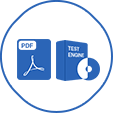Option D is the best answer because it indicates that the Product Owner and the Scrum Team are not aligned on the vision, goals, and value of the product. The Product Owner is responsible for maximizing the value of the product and the work of the Scrum Team1. Todo so, the Product Owner needs to work closely with the Scrum Team, communicate the product vision, provide clear and valuable Product Backlog items, collaborate on the Sprint Goal, and inspect and adapt the product based on feedback23. If the Increment presented at the Sprint Review does not reflect the Product Owner’s expectations, it means that there is a gap between what the Product Owner wants and what the Scrum Team delivers. This gap can lead to waste, rework, dissatisfaction, and missed opportunities. The Product Owner should work more with the Scrum Team to ensure that they have a shared understanding of the product and its value proposition, and that they deliver Increments that meet the Definition of Done and the acceptance criteria45.
Option A is not the best answer because it does not necessarily imply that the Product Owner needs to work more with the Scrum Team. People may leave the Scrum Team for various reasons, such as personal, professional, or organizational factors. While the Product Owner should care about the well-being and motivation of the Scrum Team members, and try to foster a positive and collaborative environment, the Product Owner is not accountable for the people management or the team composition1. The Scrum Master is more likely to address the issues that cause people to leave the Scrum Team, such as impediments, conflicts, or dysfunctions.
Option B is not the best answer because it does not necessarily imply that the Product Owner needs to work more with the Scrum Team. The Product Owner is expected to spend enough time with the Scrum Team to provide them with the necessary guidance and feedback2. However, the Product Owner also has other responsibilities, such as engaging with stakeholders, customers, and users, managing the Product Backlog, validating the product value, and aligning the product strategy with the business goals12. The Product Owner does not need to work full time with the Scrum Team, as long as they are available and accessible when needed, and they empower the Scrum Team to make decisions and self-organize .
Option C is not the best answer because it does not necessarily imply that the Product Owner needs to work more with the Scrum Team. The acceptance criteria for the Product Backlog items are the conditions that must be met for the items to be considered done and valuable. The Product Owner is accountable for defining and communicating the acceptance criteria to the Scrum Team1. However, the Product Owner can also collaborate with the Scrum Team and the stakeholders to refine and clarify the acceptance criteria, and to ensure that they are aligned with the Definition of Done and the Sprint Goal . The acceptance criteria for the Product Backlog items may not appear to be complete at the beginning of the Sprint, but they can be refined and updated throughout the Sprint, as long as they do not change the scope or the value of the items. The Product Owner should work with the Scrum Team to ensure that the acceptance criteria are clear, testable, and valuable, but they do not need to work more with the Scrum Team just because the acceptance criteria are not complete at a certain point in time.

